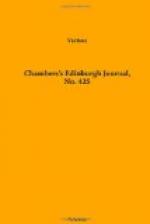It was of course impossible for the Company to suffer the blot upon their arms to remain: indeed, their safety in India required that no tarnish of defeat should rest permanently upon their name. The British troops at Candahar and Jelalabad were ordered to march upon Cabool, where, as an enduring mark of the retributary visit, in addition to pillaging the shops, setting fire to the houses, and murdering the unresisting inhabitants, they destroyed—not the fortress—but the bazaar, the great commercial depôt of Central Asia!
The objects of the war were now accomplished. But Shah Soojah was dead. The king we had driven from the throne, however, was still alive: Dost Mahomed, therefore, was restored; and nothing remained to be done, since the grand drama had been brought to a conclusion, but to celebrate the happy dénouement by a fête. This, accordingly, came off at Ferozepore. ’Then there was feasting and festivity in the gigantic tents, hung with silken flags, on which, in polyglot emblazonments, were the names of the actions that had been fought; many complimentary effusions, in the shape of after-dinner harangues; and in the mornings grand field-days, more or less, according to the “skyey influences.” The year—a most eventful one—was closed with a grand military display. The plain was covered with British and Sikh troops, and in the presence of Pertaub Singh, the heir-apparent of Lahore; Dhyan Singh, the minister; the governor-general, the commander-in-chief, and others of less note, some 40,000 men, with 100 guns, were man[oe]uvred on the great plain. On this grand tableau the curtain fell; and the year opportunely closed in gaiety and glitter—in prosperity and parade.’
We have now concluded our task, but without having been able to convey even a faint idea of the stores of information that are contained in these valuable volumes. They are destined, however, to retain a permanent place among the books of reference which enrich our national literature, and contribute to its advancement.
FOOTNOTES:
[1] History of the War in Afghanistan: from the unpublished Letters and Journals of Political and Military Officers employed in Afghanistan throughout the entire period of British Connection with that Country. By John William Kaye. 2 vols. London: Bentley. 1051.
[2] See No 291.
[3] A sketch of this famous retreat will appear in a forthcoming volume of Chambers’s Pocket Miscellany.
OCCASIONAL NOTES.
TENACITY OF LIFE IN INSECTS.




